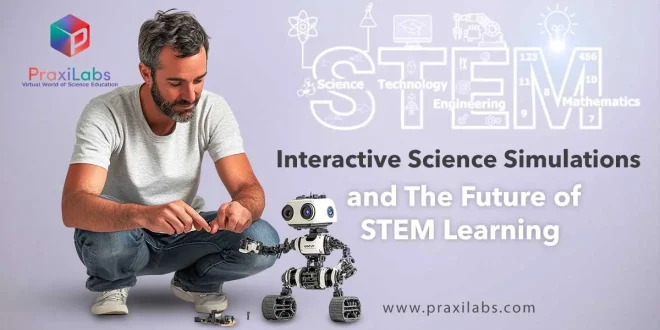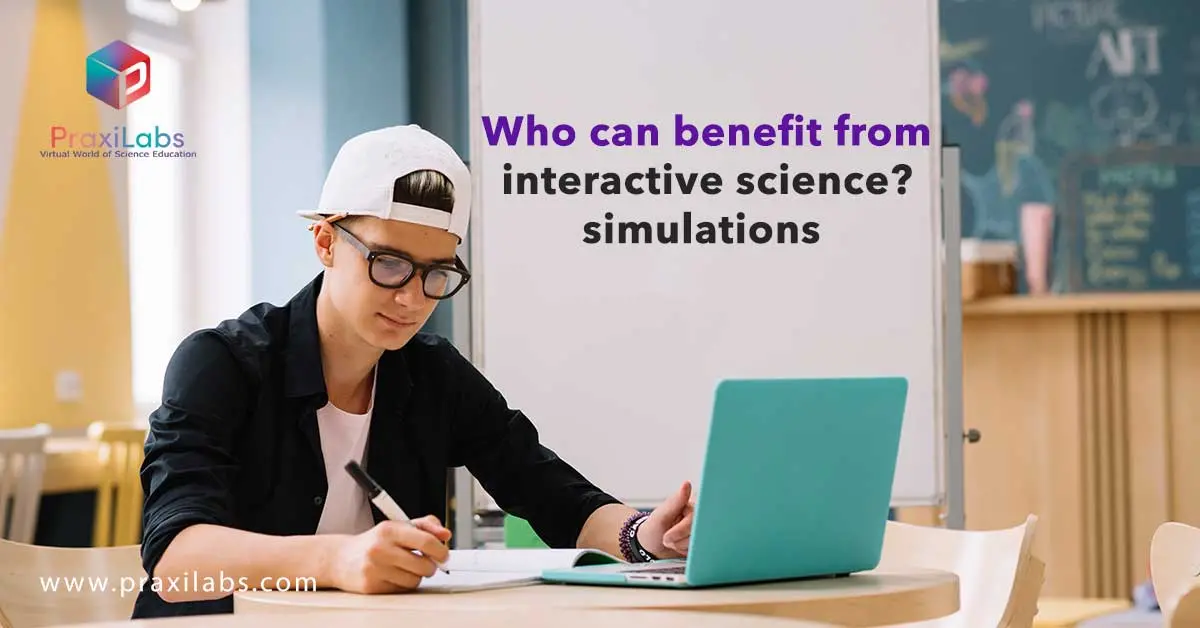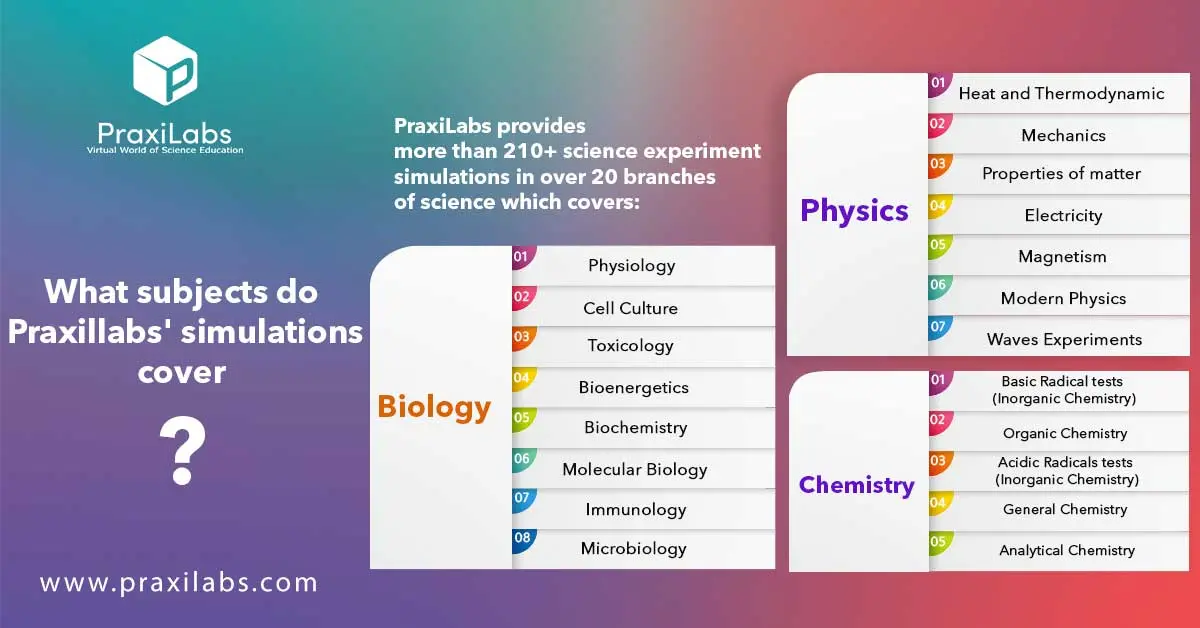Last Updated on October 5, 2025 by Muhamed Elmesery
The future of STEM education is being reshaped by interactive science simulations. These digital tools go beyond static textbooks and traditional labs, offering students immersive, hands-on experiences in a safe and cost-effective environment.
From virtual chemistry experiments to physics models and biology explorations, science interactive simulations make complex concepts more accessible, engaging, and memorable. As schools and universities embrace digital transformation, these simulations are becoming a powerful driver of innovation in STEM learning.
In this blog post, we will explore interactive science simulations, who benefits from them, why they are needed, how they support different learning environments, why using them is no longer optional, what makes Praxilabs a leading platform in scientific simulations, and more!
Table of Contents
What are interactive science simulations?
Interactive science simulations are computer-based virtual environments that simulate real science laboratories. These simulations help students understand and perform experiments by using virtual science labs, there by enhancing their learning outcomes.
Who can benefit from interactive science simulations?
Students and educational institutions can benefit from science simulations, which offer an interactive and enriching learning experience that provides students with materials, guidance, hands-on experience, and engaging approaches, which further enhance the learning process, make it more engaging, and eliminate concerns such as costs and hazards, as well as other constraints usually found in traditional labs.
The need of Interactive simulations in science education
The use and need of Interactive simulations in science education is to facilitate the understanding of complex scientific principles and theories that may be difficult to study experimentally or theoretically in a real laboratory. It also addresses the problems faced by students and educational institutions in conducting experiments in a real lab, such as:
- Safety and security-related risks.
- High costs.
- Ethical challenges.
- Limited access for students.
- Lack of student interaction and engagement.
- High failure rates among students.
- Inability to accommodate the large and increasing number of students.
- Excessive time constraints for teachers and professors.
This is where interactive science simulations come into play, allowing science experiments to be conducted in a three-dimensional virtual learning environment while providing a wide range of features, such as the ability to perform experiments anytime, anywhere, and an unlimited number of times.
How do science simulations support different learning environments?
By supporting different learning styles, each student absorbs knowledge and information differently. While class lectures, textbooks, and lab experiments are individually effective for each learning style.
Platforms that provide science simulations such as PraxiLabs combine their virtual labs with additional multimedia and text to provide each learner with material that fits their learning style. Visual, auditory, and kinesthetic learners benefit equally through multimedia content and guided interaction.
Why using science simulations in universities is no longer optional?
The use of interactive simulations in education has proven effective, as they can provide improvements in learning flexibility, safety, accessibility, interactivity, and operating costs.
Virtual science simulations are not merely transferring lectures to a video call or an online gathering—it means leveraging a virtual learning platform with updated capabilities and features. Simulations should offer innovative and creative means for better learning, which in turn reflects the importance of simulations in education.
The most important benefits and features of interactive science simulations:
Integration of structure and freedom
This integration is one of the most important advantages of virtual simulations. They give learners the freedom to choose what to work on and when to participate.
Flexibility and accessibility
Learning through virtual simulations offers much greater flexibility compared to traditional in-person learning. Interactive science simulations are designed to be safely and easily accessible to students, whether they face difficulties accessing study materials or whether it’s for all learners—without the need for travel or travel costs to attend the class.
Additionally, one of the clear benefits of interactive virtual simulations in education is that learners can easily balance their professional lives and career advancement with continuing education.
A scientific method interactive simulation offers students an engaging, hands-on way to understand how real scientific investigations are conducted. Instead of just memorizing the steps — question, hypothesis, experiment, data, and conclusion — learners actively participate in each stage through virtual experiments and data analysis.
What makes Praxilabs a leading platform in scientific simulations?
With the PraxiLabs simulation platform, students can actively learn while conducting their experiments. Students gain a complete experience, with guidance and educational materials to assist in the learning process rather than just observing experiments.
We not only provide every student with a virtual physics lab, but we also enrich their knowledge and understanding through immersive virtual experiments in a variety of subjects.
Each student absorbs knowledge and information differently. While classroom lectures, textbooks, and laboratory experiments are each effective individually for different learning styles, PraxiLabs combines its virtual lab with multimedia and supplementary texts to provide each learner with material suited to their learning style.
PraxiLabs also offers customized simulations and virtual lab solutions specifically designed to meet institutional needs. We provide a virtual science lab guide to teach safety precautions in a real laboratory and proper behavior/work conduct in real labs, saving students from potentially harmful mistakes and avoiding damage to laboratories, thereby reducing costs.
Pick the Best Virtual Plan or You
What subjects do Praxillabs’ simulations cover?
PraxiLabs scientific simulation software provides over 210 science experiment simulations in more than 20 branches of science, which include:
Physics
- Heat and Thermodynamics Experiments.
- Mechanics.
- Properties of Matter.
- Electricity.
- Magnetism.
- Modern Physics Simulations.
- Wave Experiments.
Chemistry
- Basic Radical tests (Inorganic Chemistry).
- Organic Chemistry.
- Acidic Radical tests (Inorganic Chemistry).
- General Chemistry.
- Analytical Chemistry.
Biology
- Physiology.
- Cell Culture.
- Toxicology.
- Bioenergetics.
- Biochemistry.
- Molecular Biology.
- Immunology.
- Microbiology.
Take the Next Step for Your Institution! Discover how PraxiLabs can transform your science programs. Speak with our experts to explore tailored solutions for your institution’s needs!
Frequently Asked Questions
What is interactive simulation learning?
Learning through computer-based virtual environments that simulate real environments. These simulations help students understand and perform experiments by using virtual lab for example, thereby enhancing their learning outcomes.
What are the benefits of using digital simulations?
Using digital simulations has many benefits, as they can provide improvements in learning flexibility, safety, accessibility, interactivity, and operating costs.
What is a virtual lab?
Virtual labs in science education are one of the most important techniques of e-learning, as they enable both teachers and students to achieve the educational process’ goals. This is done by facilitating the application of the practical side of the curriculum at any time and place, and without any form of restrictions.
 PraxiLabs A virtual world of science
PraxiLabs A virtual world of science








